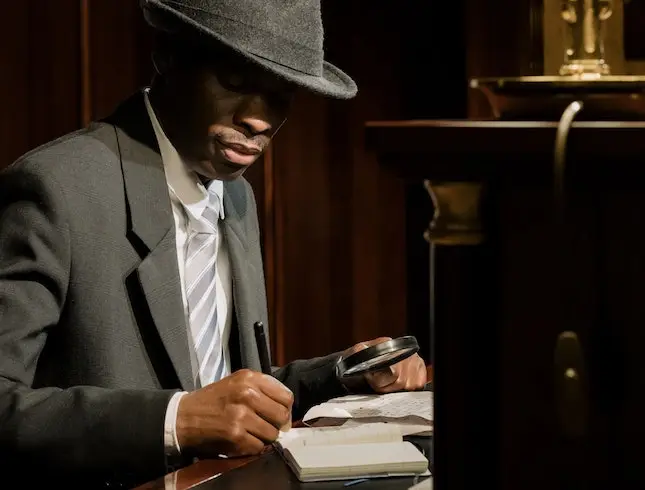How to Plant Cues in Your Mystery to Heighten Reader Involvement

You hold the remarkable power to transform readers into detectives, inviting them to step into the shoes of your protagonist.
This writing journey isn’t merely telling a story; it’s about crafting an experience, a puzzle that promises both challenge and reward. With every clue you plant, you engage your readers more deeply, making them participants in unraveling the mystery rather than mere observers. Let’s delve into the art of planting cues in your narrative, a strategy that turns pages into a landscape of intrigue and every chapter a gateway to deeper involvement.
Subtlety reigns supreme, and the careful placement of information is key to a truly immersive reading experience. Prepare to weave a web so intricate that your audience can’t help but be caught in the thrill of the chase, their minds racing to piece together the puzzle before the grand reveal.
Crafting the Reader as a Detective
Envision your reader as an observer and an active detective, engaged and invested in the narrative you weave. Here is a deliberate approach to turning your readers into sleuths, ensuring they are as involved in piecing together the puzzle as your protagonist.
Setting the Stage:
Begin by setting a stage that invites curiosity. The environment you create should do more than just describe a setting; it should hint at secrets waiting to be uncovered. Consider a seemingly mundane scene—a quiet village, a busy office, or a cozy bookstore—and imbue it with an aura of mystery. A shadow that moves against logic, a letter found in an unexpected place, whispers that speak volumes without saying much. Each detail is a seed of intrigue planted in the minds of your readers, urging them to look closer, question, and theorize.
Engage with Compelling Questions:
From the outset, pose questions that demand answers. These aren’t always grand mysteries; sometimes, they’re small, peculiar discrepancies that pique curiosity. An unexplained behavior, an anachronism in your setting, or a dialogue hints at hidden layers. While you will have one or more central mysteries driving your narrative, these smaller enigmas engage your readers, pressing them to form hypotheses constantly and eagerly anticipate revelations.
Create Interactive Clues:
Clues are more than just pieces of evidence; they are interactive elements that involve the reader in the story. Consider incorporating elements readers can mentally “interact with” or ponder over—coded messages, riddles, or maps. This approach not only involves readers on an intellectual level but also on an emotional one, as they invest effort and thought into understanding these puzzles. By making the discovery process interactive, you deepen the reader’s engagement and investment in the story.
Empower Readers through Perspective:
Offer your readers perspectives that let them feel privy to insights that characters may not yet see. This can be achieved through limited third-person narration that hops between key characters, including those on the perpetrator’s side, or carefully placed omnipresent narration glimpses. However, balance is crucial here; reveal just enough to keep readers guessing and theorizing without unveiling so much that the mystery solves itself prematurely. This dance of perspective makes readers feel like insiders, urging them to catch clues and predict the narrative, all while you control the tempo of revelations.
By viewing your narrative through the lens of involving your reader as a detective, you transform passive reading into an active, engaging experience. As you progress through your story, remember that each clue, question, and character action is an invitation to your readers—a call to engage, think, and, most importantly, become immersed in the world you’ve crafted. This approach doesn’t just create a story; it fosters an experience, setting the stage for a memorable journey through mystery and intrigue.
Mastering the Art of Clue Placement
The heart of invoking reader involvement in your mystery lies in the clues and their strategic placement throughout your narrative. Think of your story as a treasure map, with each clue a landmark guiding your readers toward the hidden treasure—the resolution of your mystery. Mastering this art requires a keen understanding of timing, subtlety, and the relationship between clue and narrative.
The Spectrum of Clues: Types and Functions
Begin by categorizing your clues into distinct types, each serving a unique purpose in your narrative. Genuine clues are direct pointers to the resolution of your mystery, while red herrings are designed to mislead and add complexity to the investigation. Though less direct, foreshadowing sets a tone or context that becomes significant as the story unfolds. Understanding the function of each type of clue allows you to weave a multi-layered puzzle that engages and challenges your readers at every turn.
Introduction and Distribution: The Tempo of Discovery
The placement of clues throughout your narrative should follow a rhythm that aligns with the unfolding of your plot and the development of your characters. Introduce genuine clues gradually, balancing them with red herrings to maintain suspense and intrigue. The key is to avoid clustering too many clues too early, which can overwhelm or confuse readers, or too late, which can lead to a rushed and unsatisfying resolution. Strategically distribute clues to maintain a steady tempo of discovery, keeping readers engaged and invested in the mystery.
Weaving Clues into Narrative Elements
Incorporate clues seamlessly into dialogue, settings, and character actions to create a cohesive narrative. Clues hidden in dialogue reveal as much about the speaker as they do about the mystery, adding depth to your characters and their interactions. Settings, when used effectively, can serve as silent witnesses to the events of your story, hiding clues in plain sight. Similarly, the actions and decisions of your characters can be revealing, offering subtle hints to observant readers. By integrating clues into these narrative elements, you enrich the storytelling experience and encourage readers to pay close attention to detail.
Enhancing Involvement through Complexity and Subtlety
Achieve a balance between making your clues challenging yet discoverable. Offer enough complexity to engage readers’ deductive skills, but ensure that clues are accessible enough to encourage continued participation in the mystery. Subtlety is your ally; clues should be present but not glaring, woven into the fabric of your story in a manner that is neither too conspicuous nor entirely obscure. This delicate balance keeps readers on their toes, eager to connect the dots while appreciating the craft behind each red herring, piece of foreshadowing, and genuine clue.
By mastering the art of clue placement, you heighten reader involvement and elevate the overall experience of your narrative. Readers become active participants in solving the mystery, their engagement fueled by the careful orchestration of clues and the gradual unveiling of the truth. With each clue serving as a step toward resolution, your story transforms into a captivating dance of intellect, imagination, and interaction.
Crafting Immersive Clue Integration
Embedding clues seamlessly into your story is crucial to truly captivate your readers. This section explores methods to integrate clues organically, ensuring your narrative remains engaging and dynamic while maintaining the essential mystery element that keeps readers hooked.
Dialogue as a Vehicle for Clues
Utilizing dialogue as a conduit for clues is a subtle yet powerful technique. Characters inadvertently reveal information, express doubts, or discuss events that, while seeming inconsequential, are pivotal to understanding the mystery. This approach provides a natural flow for clue integration and deepens character development. When a character’s words indirectly hint at larger truths, it invites readers to read between the lines, fostering an environment of engagement and speculation.
Environmental Storytelling
The setting of your story serves as a treasure trove of hidden clues. Descriptive passages about locations shouldn’t just paint a picture but embed hints within the canvas. An off-hand mention of a peculiar object in a room, the strange layout of a house, or the historical significance of a setting can all serve as subtle markers leading the observant reader closer to the truth. By embedding clues within your environment, you enrich the narrative world and provide a more immersive reading experience, encouraging readers to visualize the scenes and, in doing so, uncover hidden clues.
Character Behavior and Unspoken Cues
Actions often speak louder than words, and this couldn’t be truer in mystery writing. How a character reacts to a situation, habits, or behavior changes can all serve as unspoken clues. For instance, a character might avoid certain topics, exhibit unusual interest in seemingly mundane details, or change their routine abruptly. While not overtly revealing the mystery, such actions encourage readers to question motivations and analyze behavior, drawing them deeper into the narrative puzzle.
Foreshadowing with Precision
Effective foreshadowing involves planting seeds early in your story that will bloom into significant revelations later on. It’s about hinting at future events or outcomes in an indirect yet intentional way. However, precision is key. The foreshadowing should be subtle enough not to give the game away while being clear enough in hindsight to reward attentive readers. This technique enriches the reader’s experience through a layered understanding of the narrative and enhances the satisfaction of the mystery’s resolution.
Incorporating Technology and Modern Tools
In contemporary settings, leveraging technology can add an innovative layer to clue integration. Emails, social media posts, online articles, or text messages can all contain hidden hints or be pivotal in understanding character motivations. This modernizes the method of clue delivery and reflects how information is disseminated and consumed today, making your story more relatable and engaging for the reader.
Mystery writers can create a dense, enriching narrative tapestry by integrating clues through these methods. Each conversation, setting description, character action, or hint of foreshadowing enhances the interactive puzzle at the heart of your story. This approach draws readers in and rewards their attention and analytical skills, making the journey toward the mystery’s resolution as fulfilling as the solution itself.
Orchestrating Character Dynamics for Clue Revelation
The characters in your mystery don’t just drive the plot; they are crucial to dispersing the web of clues that captivate and intrigue your readers. Understanding how to use their roles and relationships as mechanisms for clue revelation can significantly heighten reader involvement, transforming your characters from mere pawns into masterful conductors of suspense and discovery.
The Protagonist’s Journey of Discovery
Your protagonist is the reader’s anchor in the storm of unfolding events. How you place clues about this central figure can significantly impact the reader’s engagement level. Use your protagonist’s interactions, observations, and deductions to reveal clues gradually. Their journey should mirror the reader’s process of piecing together the puzzle, making their moments of realization ours as well. Consider moments of introspection or dialogue where the protagonist ponders over a piece of evidence or recalls a critical conversation, offering readers a chance to connect the dots alongside them.
The Supporting Cast’s Unwitting Revelations
Secondary characters serve as invaluable reservoirs for clue dispersion. Their actions, words, and omissions allude to hidden aspects of the mystery. For instance, a seemingly offhand comment from a side character can set off a chain of thought in both the protagonist and the reader. Alternatively, their unique perspectives offer fresh angles on the mystery, spotlighting details that the protagonist might overlook. By embedding clues within the fabric of your supporting characters’ interactions and backstories, you deepen the plot and enrich the narrative with their diverse viewpoints.
Antagonists and Misdirection
The antagonist or the potential suspects in your story are essential for weaving complexity into the narrative through misdirection. Red herrings can often stem from these characters’ actions or information associated with them that leads the protagonist and the reader astray. However, genuine clues can be hidden in plain sight within this misdirection. The subtlety with which you handle their motivations, lies, or the truth they try to conceal are pivotal in keeping the audience guessing, making the eventual revelation all the more satisfying.
Minor Characters as Clue Carriers
Do not underestimate the power of a well-placed minor character to deliver a clue that can change the course of the investigation. These characters can cross paths with the protagonist or the supporting cast in seemingly inconsequential encounters that, in hindsight, are pivotal moments of revelation. Because of their fleeting presence, readers might initially overlook the significance of their words or actions, which makes these characters perfect vehicles for discreetly planting clues.
Dynamic Interplay for Enhanced Engagement
The dynamic interplay between your characters provides a rich tapestry for clue integration. As relationships evolve and power dynamics shift, opportunities arise to reveal new information or cast existing details in a new light. This constant movement keeps the narrative vibrant and challenges readers to reevaluate their theories in light of new developments. Encourage your readers to actively engage with the story by considering the clues themselves and how the interconnectedness of your characters’ lives might influence the unfolding mystery.
By skillfully orchestrating your characters and their dynamics, you create a living, breathing world that’s ripe with intrigue. Each character, from the protagonist to the most fleeting cameo, plays a vital role in the dance of deception and discovery that defines a captivating mystery. Their overt and subtextual interactions are the veins through which clues can flow seamlessly, engaging your readers not just as observers but as co-investigators drawn into the heart of the narrative puzzle.
Navigate Pitfalls in Clue Integration
While the strategic placement of clues is pivotal to crafting a compelling mystery, there are common pitfalls that can disrupt the narrative flow or disengage readers. Recognizing and avoiding these traps will enhance the cohesion of your story and maintain suspense without sacrificing clarity or reader involvement.
Striking the Right Balance Between Concealment and Revelation
One of the most delicate aspects of mystery writing is managing the tension between hiding and revealing information. If clues are too conspicuously placed, they may strip the mystery of its intrigue, leading readers to solve the puzzle prematurely. Conversely, excessively obscure clues can foster frustration or detachment, as readers may feel the solution was not achievable with the information provided. Aim for a middle ground, where clues are integrated organically into the narrative, allowing astute readers to gather them piece by piece without feeling spoon-fed or left in the dark.
Maintaining Logical Consistency
A common mistake in mystery narratives is the introduction of clues that later prove to be inconsistent with the story’s logic or resolution. This breaks the reader’s immersion and trust in the narrative. Ensure every clue you plant has a clear purpose and aligns with the plot and character motivations. Revisit your clues during revisions to confirm they contribute meaningfully to the mystery and don’t contradict the eventual outcome.
Avoiding Over-reliance on Red Herrings
While red herrings are invaluable for creating misdirection and complexity, overusing them can lead to reader fatigue and diminish the impact of genuine clues. Your audience might start to dismiss important information as yet another diversion, undermining the critical moments of revelation. Use red herrings judiciously, balancing them with authentic cues that advance the narrative and enrich the puzzle, ensuring your readers remain engaged and rewarded for their attentiveness.
Ensuring Diversity in Clue Presentation
Repetition in clue presentation, such as relying solely on dialogue or physical evidence, renders the mystery monotonous. To keep readers invigorated and involved, diversify how clues are delivered. Incorporate a mix of dialogue, setting descriptions, character actions, and even thematic elements as vehicles for clues. Such variety makes the discovery process more enjoyable for the reader and mirrors the complexity of real-world problem-solving, where clues can come from unexpected sources.
Steering Clear of Clichés and Predictability
Mystery genres are ripe with conventions and tropes, some of which can border on cliché if not handled with originality. Readers familiar with the genre might grow disinterested if the narrative heavily leans on predictable plot devices or clichéd clues. Strive for freshness in how clues are integrated and revealed, challenging genre expectations and offering new twists that surprise and delight your audience. This approach maintains engagement and cements your story as a unique contribution to the mystery genre.
Successfully navigating these pitfalls requires a keen understanding of your story’s mechanics and a deep respect for your readers’ intelligence and engagement. By carefully managing the balance between concealment and revelation, maintaining logical consistency, moderating the use of red herrings, diversifying clue presentation, and avoiding clichés, you can craft a mystery that is both challenging and satisfying, rewarding your readers with a rich, immersive experience that stands the test of time.
Analyzing Clue Placement in Renowned Mysteries
To fully grasp the art of clue integration, it’s beneficial to study how master storytellers have navigated this complex terrain in iconic mystery works. These analyses offer valuable insights into effective methods of clue dispersion and highlight innovative strategies that have captivated readers over the years.
A. “The Hound of the Baskervilles” by Arthur Conan Doyle
Conan Doyle’s classic stands as a testament to meticulous clue crafting and strategic placement. Notice how the author interweaves legend with evidence, blending supernatural elements with tangible clues. The narrative cleverly deploys red herrings (such as the convict’s escape and the mysterious figure on the moor) while seeding critical information (the portrait of Hugo Baskerville, the peculiar actions of Stapleton) in a way that challenges but does not outpace the reader. Conan Doyle exemplifies controlling the flow of information, allowing Holmes (and, by extension, the reader) to piece the puzzle together in a satisfying crescendo of revelation.
B. “Gone Girl” by Gillian Flynn
Flynn’s contemporary masterpiece offers a masterclass in using unreliable narrators to manipulate clue placement. The alternating perspectives between Nick and Amy provide conflicting accounts, forcing readers to question the veracity of each character’s narrative. Flynn uses diary entries, media snippets, and character actions as multifaceted clues, building a complex picture of the truth. This novel highlights how manipulating reader perception through character reliability can add depth and intrigue to the mystery, keeping readers engaged until the shocking revelations.
C. “Murder on the Orient Express” by Agatha Christie
Christie’s ingenious use of setting as a constraint and catalyst for clue distribution showcases her skill in pacing and plot intricacy. By confining the story to a train, she elevates tension and focuses the reader’s attention on a limited set of suspects, each with a motive. The seemingly disconnected clues (a scarlet kimono, a pipe cleaner, a conductor’s uniform) are masterfully interconnected, demonstrating how diversifying clue types and ensuring each character’s involvement can create a layered, engaging puzzle.
D. “The Big Sleep” by Raymond Chandler
Chandler’s fusion of gritty realism with complex plotting illustrates how setting and atmosphere can serve as a backdrop for clue integration. Through Philip Marlowe’s hard-boiled lens, Los Angeles becomes a character in itself, where every shadowed alley and opulent mansion harbors secrets. Chandler’s strategic use of dialogue and descriptive detail plants clues that feel inherent to the world he’s constructed, epitomizing how effective atmosphere and character perspective can enhance the mystery and the reader’s envelopment in the story.
E. “The Girl with the Dragon Tattoo” by Stieg Larsson
Larsson demonstrates modern clue integration by weaving together multiple narrative threads, incorporating technology, and examining societal issues within the framework of a mystery. The intertwining of personal histories with corporate intrigue and legal complexity illustrates a multi-layered approach to presenting clues. This novel exemplifies the modern mystery’s capability to use diverse media (emails, photographs, and financial records) and deep character backstories as vehicles for clues, showcasing the genre’s evolution in addressing contemporary audiences.
Analyzing these examples illuminates common themes and diverse strategies in successful clue integration. These works underscore the importance of balancing revelation with misdirection, leveraging narrative elements (setting, character, and perspective), and innovating within genre conventions to craft mysteries that stand not only as puzzles to be solved but as stories that resonate and engage on multiple levels. As you work on your mystery, consider how these lessons might influence your approach to planting clues, always to deepen reader involvement and satisfaction.
Craft Mysteries That Mesmerize
Embedding clues within your narrative isn’t just about keeping your readers guessing; it’s about engaging them in a cerebral dance, a partnership where every step, turn, and flourish leads to the grand finale. The journey from the opening mystery to the closing revelation should be laden with challenges, surprises, and moments of triumph for your characters and readers.
The essence of a great mystery lies not in the complexity of the plot, but in the delicate balance between revealing and concealing, guiding and misleading. Your goal is to plant clues with such finesse that your readers relish the thrill of the chase, delight in their moments of insight, and marvel at the ingenuity of your construction when all is unveiled.
The arbiters of your success are the readers who eagerly leap into the world you’ve constructed, ready to decode its secrets and driven by the compulsion to understand.
Ultimately, the art of mystery writing is a delicate alchemy that transforms curiosity into fascination, weaving threads of the ordinary into a tapestry of extraordinary intrigue. As you hone your craft, remember that the ultimate achievement is not just in creating puzzles to be solved but in crafting experiences that linger in the minds and hearts of your readers long after the mystery has been unveiled.
Unveil the Secrets, Write a Killer Mystery
Introducing Write A Killer Mystery, the definitive course designed to transform your intriguing ideas into captivating, suspense-filled masterpieces. This isn’t just another writing course; it’s your blueprint to structuring the perfect mystery novel, a guide crafted by an author who has navigated the twists and turns of mystery writing and come out victorious.
Why Choose Write A Killer Mystery?
– Expert Guidance: Learn from a seasoned mystery writer who shares not just their successes but the pitfalls to avoid.
– Interactive Learning: Engage in exercises that put theory into practice, challenging you to think like a detective and a writer.
– Peer Reviews: Become part of a supportive community, offering feedback and sparking inspiration through collaboration.
– Access to Resources: From checklists for plotting your mystery to character development templates, everything you need is at your fingertips.
– Flexibility: Progress at your own pace, fitting the course around your life and writing rituals.
Every chapter of your story is a step closer to the climax, and with Write A Killer Mystery, you’re assured that every page you write builds suspense and confidence as a mystery writer.
Enroll in Write A Killer Mystery today, and transform fleeting ideas into enthralling realities that captivate the imagination and challenge the intellect. Your journey from aspiring writer to celebrated mystery author starts now. Uncover the secrets to creating narratives that ensnare, entertain, and endure.
Don’t just dream of writing a mystery. Write a mystery that others dream of solving.
Photo by Annie Spratt on Unsplash




